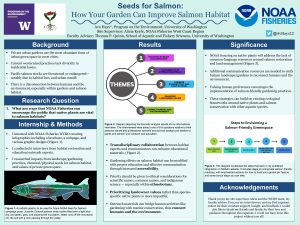SEEDS FOR SALMON: HOW YOUR GARDEN CAN HELP SALMON HABITAT
Salmon are a cultural icon in the Pacific Northwest, but their populations are declining due to overfishing, habitat loss, climate change, and urban runoff. This study highlights the potential for individuals to mitigate harm and support salmon populations through gardening practices. The aim of this study involved investigating how native plants contribute to salmon habitat, and how we can encourage the public to choose them. I explored the importance of landscapes, creating resilient garden spaces, ethnobotanical significance, and effective communication strategies while interning with NOAA Fisheries‚ West Coast Region for their Seeds for Salmon campaign. I identified characteristics of native, nonnative, and invasive plant species, the chemical and physical needs of salmon, and how this overlap. I also conducted six interviews with habitat restoration experts, technicians, and education/outreach coordinators to understand perspectives of those involved with salmon and native plants. I found that by prioritizing transdisciplinary collaboration, landowner values, increasing accessibility of outreach materials, and connecting humans with the environment are vital components of successful communication around native plants and their benefits to gardens and salmon habitat. These practices can initiate individual involvement in salmon-friendly gardening practices, promote knowledgeable perspectives around native, nonnative, and invasive plant use in garden spaces, and cultivate passion for salmon habitat restoration and conservation. Amplifying these practices in marine science communication can promote the connection of terrestrial and marine environments and facilitate better human relationships with the broader environment‚ creating more resilient spaces in the face of climate change.
